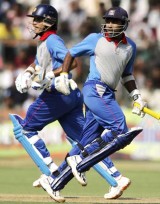Wrong place, wrong time
Too many things went wrong for the Afro-Asia Cup, from the weather to the shirt sponsorship, but the cricket was of a high standard
Kanishkaa Balachandran
13-Jun-2007
|
|

|
When broadcaster Nimbus pulled out of its deal to telecast the Afro-Asia Cup,
it seemed like the last straw for a tournament that was already struggling for credibility and acceptance. And as the tournament unfolded, over the past week, those suspicions seemed confirmed: Low spectator support, little advertising of any sort, an Africa team shorn of stars and terrible cricketing weather.
The silver lining was the cricket itself, which reached a much higher standard than expected. Mahendra Singh Dhoni's power hitting, Shaun Pollock's spirited 130, AB de Villiers's electric catching and the Africa XI crossing 300 while chasing in each of the matches provided enough entertainment to those who bothered to turn up (or tune in).
Yet there are several questions to be asked of the organisers, the Asian Cricket Council (ACC) and the African Cricket Association (ACA). It was quite bizarre seeing a combined Asian side, wearing ad-free shirts, walk on to a lush green outfield devoid of signages and sponsor logos in the heart of cricket's economic powerhouse. The African side bore the logo of Sahara Computers, the official team sponsor, so how come their opponents lost out?
One clue to this lies in the fact that the ACC had sold the television and marketing rights to the broadcaster, so Nimbus's pull-out, 10 days before the tournament started, affected more than just the telecast. Indeed, the telecast issue was sorted out soon enough when ESPN-Star stepped in but the channel had no advertisements for the first ODI in Bangalore and didn't telecast the post-match presentation.
|
|
"ESPN came in very conveniently because the meetings were in Singapore", Shahriar Khan, the ACC's media officer, told Cricinfo. "Still, it was obviously very difficult for them as it would be for any other organisation to rope in sponsors at such short notice, print the boards and the T-shirts etc."
The Africans had a shirt sponsor because Sahara Computers is based in South Africa, which supplied four cricketers to the squad. "The Asian side is a mix of four different Test countries", Khan said, "and the ACC, unlike the ACA (based in Johannesburg) is based in Malaysia so the process of holding formalised meetings is just a little complex." It doesn't explain, though, why no Indian company could be roped in.
The bigger issue was the timing of this series. A cramped international calendar meant that the matches had to be scheduled in June, the height of the Indian summer; worse still, back to back matches were played in Chennai, where the mercury shoots up to unforgiving levels.
The ACC maintains that the positioning of the tournament in the calendar year and the choice of venues wasn't something within their control. The first was dependent on the ICC's Future Tours Programme, the second on the BCCI's venues rotation policy which decreed one match in Bangalore and two in Chennai.
|
|

|
But the back-to back matches? Khan's explanation doesn't really hold ground. "It is unfortunate for the players. If the players are agreeable via their boards to play back-to-back matches then it can happen. Such games are of commercial value, especially with games over the weekend. The theme of the Afro Asia cup is not to make huge profits and whatever money we earn is ploughed back into the game so that kids from countries like Uganda get opportunities to play. It's a little sacrifice to make and both the players and the boards understand. We feel for the players and so do the boards."
That may not be enough to mollify the players, who were visibly affected by the heat and humidity, especially in Chennai. Indeed, the Africa XI had four players unwell for the last match and their captain, Justin Kemp, said it as plainly as possible given the code of conduct. "It's hard for many of us coming in after the African winter," Kemp repeated on a few occasions. "The humidity is on the increase and one way to combat that is to give our bowlers short spells."
If the aim was to maximise the revenues from the weekend crowd, the eventual spectator turn-out seemed barely enough for the organisers to break even. In Bangalore, fans were given a free ticket for the Twenty20 games with every ODI ticket purchased. This was a bid to fill up the stands and generate an atmosphere deserving of an international game, which was evident in the Twenty20 game under lights. Monetarily, there wouldn't have been much for the organisers there.
Lessons will hopefully be learnt when the next edition gets underway in Kenya next year. What's required is flexibility in scheduling matches in India, taking into account the players' and spectators' interests. Till that happens, the Afro Asia Cup will continue to exist, only in spirit.
Kanishkaa Balachandran is an editorial assistant on Cricinfo